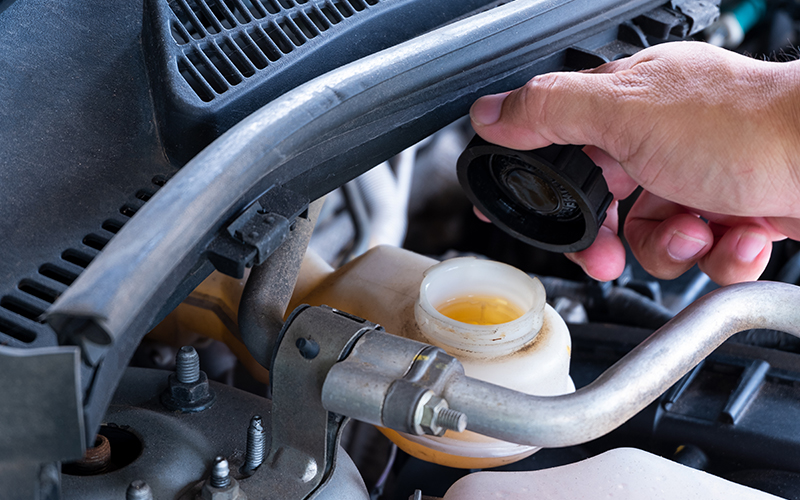Brake fluid control and replacement – safe braking condition
Proper service of the braking system is not only a periodic inspection and replacement of brake discs and pads. An equally important and often overlooked element is the brake fluid. Why is regular inspection and replacement so important?

Brake fluid tasks
The main function of brake fluid is to transfer power from the brake pedal, through the brake lines, to the pads. It is therefore very important that the fluid can withstand the high temperatures found in the brake system. The fluid in the system should never be brought to a boil. This can lead to blockage of the braking system. The higher the boiling point, the higher the fluid grade.
DOT 3 grade brake fluid has a boiling point of about 205°C, but when it absorbs water, it begins to boil at 140°C. DOT 4 grade fluid boils at around 230°C, but wet fluid – already at 155°C. For vehicles equipped with modern hydraulic systems, it has become necessary to use a fluid with better parameters.
In modern vehicles equipped with brake assist systems such as ABS, EBD, BAS, Electronic Stability Program (ESP), Traction Control (TCS, ASR), the quality of brake fluid is particularly important. In these systems it is necessary to use high quality brake fluids with reduced viscosity (LV, ESL), of the Shell DOT 4 ESL class. When higher viscosity fluids are used, response times in critical situations can be significantly longer. ESL-grade fluids are low-viscosity fluids that ensure adequate fluid flow at low temperatures, which is particularly important in systems with ABS and electronic safety systems: road stability and traction control.
Shell DOT 4 ESL fluid meets the advanced requirements of ISO 4925 Class 6 (for ABS, ESP systems). It has a high boiling point at the typical value of 265°C (ERBP) and 168°C (WERBP). The additive package that it contains ensures optimum lubricating properties, which prevents premature wear and abrasion of metal and rubber parts in the brake system.
Protecting the components of the system from wear is also one of the most important tasks of brake fluid. The complexity of modern braking systems requires brake fluid to be compatible with many different materials (metals, metal alloys, elastomers, polymers, rubber).
Why does the brake fluid need to be changed regularly?
With the passage of time and the increasing mileage of a vehicle, brake fluid is prone to losing its basic properties. This is mainly due to the fluid’s hygroscopic nature, i.e. its susceptibility to water absorption. In theory, the braking system is a closed system, but moisture is able to penetrate through it in places of connections between elements or through flexible hoses (especially when these are already worn out). It is no coincidence that manufacturers are obliged to give separate figures for the boiling point of “dry” and “wet” fluids. Wet fluid, i.e. fluid containing water absorbed from the environment, has a much lower boiling point.
Checking the brake fluid level
Decreased braking quality can also be associated with a significant fluid loss from the system. This can occur as a result of leaks, mainly in the brake lines. To prevent this type of situation, it is worth regularly checking the level of fluid in the tank. If you notice any irregularities, thoroughly check the system for leaks or have this done by a car mechanic. Regular control and quick reaction will protect us from dangerous situations on the road. Increasing leakage can cause the brakes to fail while driving.
How often to change the brake fluid and which one to choose?
Regular fluid change is necessary. It is advisable to follow the vehicle manufacturer’s recommendations regarding fluid grade and replacement intervals. However, do not rely solely on the mileage of the vehicle (much depends on the driver’s driving style and the level of brake wear). Regular replacement is also necessary for cars with lower mileage. The fluid should not remain in the system for more than 2-3 years. We should also remember about changing the fluid during each service which includes replacement of system elements (discs and/or brake pads).
For the vast majority of cars on public roads the DOT-4 class brake fluid is recommended. Already in the 1990s it replaced the DOT-3 class fluid that had been widely used before. Nowadays, there are improved versions of DOT-4 fluid on the market (e.g. Shell DOT-4 ESL) that are recommended for cars equipped with safety systems (ABS, ESP, ASR, EBD and other). They are characterized by lower viscosity.
When choosing a brake fluid for your vehicle, it is best to focus on the offers of experienced manufacturers. Remember that it is one of the elements directly responsible for driving safety. Only fluids of the highest quality are able to ensure chemical stability, thermal control, performance and optimum protective properties for a long time. This translates into a quick response of the braking system and, consequently – a shorter braking distance.
Read more about the brake fluids we offer »

